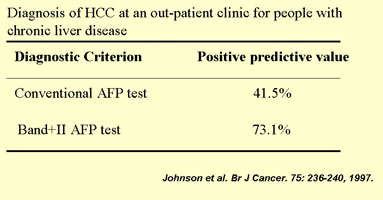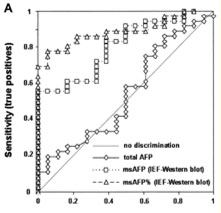Tumor Marker Lab
Research in the Tumour Marker Laboratory involves two main areas: screening of novel anticancer drugs and the study and identification of cancer markers for drug targeting, diagnosis and prognosis. Successful application of these markers would be very useful in: 1) screening for the presence of cancer; 2) diagnosing a specific type of cancer; 3) determining prognosis and 4) monitoring the course of remission following treatment. Our focus is on cancers commonly found in Southeast Asia including Hong Kong and China such as lung cancer, hepatocellular carcinoma (HCC) and nasopharyngeal carcinoma (NPC).
Screening for the anticancer properties of novel drugs is performed using both in-vitro cell culture systems and in-vivo animal models in our lab. Currently, we are actively involved in the screening of novel drugs for the treatment of lung cancer and NPC. The pre-clinical evaluation of such drugs has laid down the foundation for their use in the clinic for patient treatment. Elucidation of protein targets of different drugs also allows us to find better markers for a particular cancer type.
With the use of state-of-the-art equipment, analyses of global differences in protein / peptide expression patterns are performed in our lab using 2D-PAGE, MALDI-TOF, SELDI, HPLC and ICAT. Specific proteins of interest are also studied using immunohistochemical technique. Differentially expressed proteins / peptides, in combination with clinical data, are then evaluated for their potential as tumour markers which are then further characterized by molecular technique such as quantitative RT-PCR.
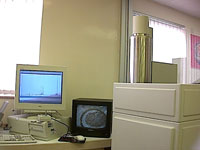
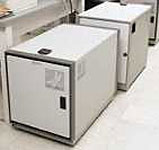
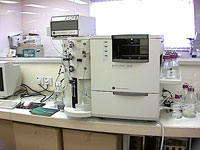
Current and previous research topics from our lab include:
1.Identification of differentially expressed proteins using proteomic approaches
2.Evaluation of novel drugs for their anticancer properties
3.Identification and evaluation of the use of alpha feto-protein (AFP) tumour specific variants in HCC diagnosis
4.Development of computer algorithms (Neural Network, Classification Tree) integrating tumor marker information and patient variables for improving the diagnosis of cancers such as HCC
Publications
| 1. Ma, B.B., Hui, E.P., Wong, S.C., Tung, S.Y., Yuen, K.K., King, A, Chan, S.L., Leung, S.F., Kam, M.K., Yu, B.K., Zee, B., Chan, A.T. Multicenter phase II study of gemcitabine and oxaliplatin in advanced nasopharyngeal carcinoma-correlation with excision repair cross-complementing-1 polymorphisms. Annals of Oncology, in press. |
| 2. Wong, S.C., Chan, C.M., Ma, B.B., Lam, M.Y., Choi, C.G., Au, T.C., Chan, A.S., Chan, A.T. Advanced proteomic technologies for cancer biomarker discovery. Expert Review of Proteomics, in press. |
| 3. Hung, E.C., Shing, T.K., Chim, S.S., Yeung, P., Chan, R.W., Chik, K.W., Lee, V., Tsui, N.B., Li, C.K., Wong, C.S., Chiu, R.W., Lo, Y.M. Presence of donor-derived DNA and cells in the urine of sex-mismatched hematopoietic stem cell transplant recipients: implication to the transrenal hypothesis. Clin Chem, 55:715-722, 2009. |
| 4. Wong, S.C., Chan, C.M., Ma, B.B., Hui, E.P., Ng, S.S., Lai, P.B., Cheung, M.T., Lo, E.S., Chan, A.K., Au, T.C., Lam, M.Y., Chan, A.T. Clinical significance of cytokeratin 20-positive circulating tumor cells detected by a refined immunomagnetic enrichment assay in colorectal cancer patients. Clin Cancer Res, 15:1005-1012, 2009. |
| 5. Hui, E.P., Sung, FL, Yu, BK, Wong, C.S., Ma, B.B., Lin, X, Chan, AS, Wong, WL, Chan, AT. Plasma osteopontin, hypoxia, and response to radiotherapy in nasopharyngeal cancer. Clin Cancer Res, 14:7080-7087. |
| 6. Wong, C.S., Wong V.W., Chan, C.M., Ma, B.B., Hui, E.P., Wong, M.C., Lam, M.Y., Au, T.C., Chan, W.H., Cheuk, W., Chan, A.T. Identification of 5-FU response proteins in colorectal carcinoma cell line SW480 by two-dimensional electrophoresis and MALDI-TOF mass spectrometry. Oncology Reports, 20:89-98, 2008. |
| 7. Wong, C.S., Cheung, M.T., Ma, B.B., Hui, E.P., Chan, A.C., Chan, C.K., Lee, K.C., Cheuk, W., Lam, M.Y., Wong, M.C., Chan, C.M., Chan, J.K., Chan, A.T. Presence of cytokeratin 20 positive cells in pN0 lymph nodes and circulating cytokeratin 20 mRNA in pN0 colorectal cancer patients. Int. J. Surg. Pathol., 16:119-26, 2008. |
| 8. Chan, C.M., Wong, S.C., Lam, M.Y., Hui, E.P., Chan, J.K., Lo, E.S., Cheuk, W., Wong, M.C., Tsao, S.W., Chan, A.T. Proteomic comparison of nasopharyngeal cancer cell lines C666-1 and NP69 identifies down-regulation of annexin II and beta2-tubulin for nasopharyngeal carcinoma. Arch. Pathol. Lab. Med.,132:675-683, 2008. |
| 9. Ying, J., Li, H., Yu, J., Ng, K.M., Poon, F.F., Wong, S.C., Chan, A.T., Sung, J.J., Tao, Q. WNT5A exhibits tumor-suppressive activity through antagonizing the Wnt/β-catenin signaling, and is frequently methylated in colorectal cancer. Clin. Cancer Res., 14: 55-61, 2008. |
| 10. Wong, S.C., Ma, B.B., Lai, P.B., Ng, S.S., Lee, J.F., Hui, E.P., Lam, M.Y., Chan, C.M., Chan, A.T. Redistribution of mRNA in plasma, mononuclear and red cells by centrifugation opens up a new scenario in expression profiling in blood from patients with metastatic colorectal cancer. Clin. Biochem., 40:1277-1284, 2007. |
| 11. Wong, S.C., Chan, J.K., Lo, E.S., Chan, A.K., Wong M.C., Chan, C.M., Chan, A.T. The contribution of bifunctional Skip-Dewax pre-treatment solution, rabbit monoclonal antibodies and polymer detection systems in immunohistochemistry. Arch. Pathol. Lab. Med., 131:1047-1055, 2007. |
| 12. Chiu, R.W., Chim, S.S., Wong, I.H., Wong, S.C., Lee, C.W., To, K.F., Tong, J.H., Yuen, R.K., Shum, A.S., Chan, J.K., Chan, L.S., Yuen, J.W., Tong, Y.K., Fung-Weier, J., Ferlatte, C., Leung, T.N., Lau, T.K., Lo K.W., Lo Y.M. Hypermethylation of tumor suppressor genes in human placenta. Am. J. Pathol., 170: 941-950, 2007. |
| 13. Mok, T.S., Choi, E.P., Yau, D.M., Johri, A., Yeo, W., Chan, A.T., Wong, C.S. Effects of Patupilone (epothilone B; EPO906) – A novel chemotherapeutic agent – in hepatocellular carcinoma: an in vitro study. Oncology, 71:292-296, 2007. |
| 14. Chan, C.M., Ma, B.B., Hui, E.P., Wong, S.C., Mo, F., Leung, S.F., Kam, M., Chan, A.T. Cyclooxygenase-2 expression in advanced nasopharyngeal carcinoma – a prognostic evaluation and correlation with hypoxia inducible factor 1α and vascular endothelial growth factor. Oral Oncology, 43:373-378, 2007. |
| 15. Wong, S.C., Chan, A.T., Chan, J.K., Lo, Y.M. Nuclear β-catenin and Ki-67 expression in choriocarcinoma and its pre-malignant form. J. Clin. Pathol., 59: 387-392, 2006. |
| 16. Chan, C.M., Ma, B.B., Wong, S.C., Chan, A.T. Celecoxib induces dose dependent growth inhibition in nasopharyngeal carcinoma cell lines independent of cyclooxygenase-2 expression. Biomed. Pharmacother., Suppl 2:S268-271, 2005. |
| 17. Wong, S.C., Chan, A.T., Lo, E.S., Lo, Y.M. Nuclear β-catenin expression is rare and its potential with short survival in colorectal signet-ring cell carcinoma. Appl. Immuno. & Mol. Morpho., 13: 248-251, 2005. |
| 18. Wong, S.C., Chan, J.K., Lee, K.C., Lo, E.S., Tsang, D.N. Development of a quantitative assay for SARS coronavirus and correlation of GAPDH mRNA to SARS coronavirus in clinical specimens. J. Clin. Pathol., 58:276-280,2005. |
| 19. Wong, S.C., Lo, E.S., Lee, K.C., Chan, J.K., Hsiao, W.L. Prognostic and diagnostic significance of β-catenin nuclear immunostaining in colorectal cancer. Clin. Cancer Res.,10:1401-1408, 2004. |
| 20. Wong, S.C., Lo, E.S., Cheung, M.T. An optimized protocol for extraction of non-viral mRNA from human plasma frozen for three years. J. Clin. Pathol., 57:766-768, 2004. |
| 21. Wong, S.C., Lo, E.S., Cheung, M.T., Ng, E.K., Tse, C.W., Lai, P.B., Lee, K.C., Lo, Y.M. Quantification of plasma β-catenin mRNA in colorectal cancer and adenoma patients. Clin. Cancer Res., 10: 1613-1617, 2004. |
| 22. Cheuk, W., Wong, K.O., Wong, C.S., Chan, J.K. Consistent Immunostaining for cyclin D1 can be achieved on a routine basis using a newly available rabbit monoclonal antibody. Am. J. Surg. Pathol., 28:801-807, 2004. |
| 23. Cheuk, W., Wong, K.O., Wong, C.S., Dinkel, J.E., Ben-Dor, D., Chan, J.K. Immunohistochemical staining for human herpesvirus 8 latent nuclear antigen 1 helps distinguish Kaposi sarcoma from its mimickers. Am. J. Clin. Pathol., 121: 335-342, 2004. |
| 24. Wong, S.C., Lo, E.S., Chan, A.K., Lee, K.C., Hsiao, W.L. Nuclear β-catenin as a potential prognostic and diagnostic marker in colorectal cancer patients from Hong Kong. J. Clin. Pathol. (Mol. Pathol.), 56: 347-352, 2003. |
| 25. Wong, S.C., Lo, S.F., Lee, K.C., Yam, J.W., Chan, J.K., Hsiao, W.L. Expression of frizzled-related protein and Wnt-signalling molecules in invasive human breast tumours. J. Pathol., 196: 145-153, 2002. |
| 26. Ng, E.K., Tsui, N.B., Chiu, R.W., Yu, S.C., Wong, S.C., Lo, E.S., Rainer, T.H., Johnson, P.J., Lo, Y.M. Presence of filterable and nonfilterable mRNA in the plasma of cancer patients and healthy individuals. Clin. Chem., 48: 1212-1217, 2002. |
| 27. Wong, S.C., Chan, J.K., Lee, K.C., Hsiao, W.L. Differential expression of p16/p21/p27 and cyclin D1/D3, and their relationships to cell proliferation, apoptosis, and tumour progression in invasive ductal carcinoma of the breast. J. Pathol., 194: 35-42, 2001. |
| 28. Chan, J.K., Wong, C.S. Loss of E-cadherin is the fundamental defect in diffuse-type gastric carcinoma and infiltrating lobular carcinoma of the breast. Adv. Anat. Pathol., 8: 165-172, 2001. |
| 29. Chan, J.K., Wong, C.S., Ku, W.T., Kwan, M.Y. Reflections on the use of controls in immunohistochemistry and proposal for application of a multitissue spring-roll control block. Ann. Diagn. Pathol., 4: 329-336, 2000. |
| 30. Tsui, W.M., Lam, P.W., Lee, K.C., Ma, K.F., Chan, Y.K., Wong, M.W., Yip, S.P., Wong, C.S., Chow, A.S., Lo, S.T. The C282Y mutation of the HFE gene is not found in Chinese haemochromatotic patients: multicentre retrospective study. Hong Kong Med. J., 6: 153-158, 2000. |
| 31. Wong, K.F., Chan, J.K., Lo, E.S., Wong, C.S. A study of the possible etiologic association of Epstein-Barr virus with reactive hemophagocytic syndrome in Hong Kong Chinese. Hum. Pathol., 27: 1239-1242, 1996. |
| 32. Chan, J.K., Yip, T.T., Tsang, W.Y., Lau, W.H., Wong, C.S., Ma, V.W. Detection of Epstein-Barr virus in Hodgkin’s disease occurring in an Oriental population. Hum. Pathol., 26: 314-318, 1995. |
| 33. Chan, J.K., Tsang, W.Y., Ng, C.S., Wong, C.S., Lo, E.S. A study of the association of Epstein-Barr virus with Burkitt’s lymphoma occurring in a Chinese population. Histopathology, 26: 239-245, 1995. |
| 34. Chan, J.K., Yip, T.T., Tsang, W.Y., Poon, Y.F., Wong, C.S., Ma, V.W. Specific association of Epstein-Barr virus with lymphoepithelial carcinoma among tumors and tumor-like lesions of the salivary gland. Arch. Pathol. Lab. Med., 118: 994-997, 1994. |
| 35. Chan, J.K., Yip, T.T., Tsang, W.Y., Ng, C.S., Lau, W.H., Poon, Y.F., Wong, C.S., Ma, V.W. Detection of Epstein-Barr viral RNA in malignant lymphomas of the upper aerodigestive tract. Am. J. Surg. Pathol., 18: 938-946, 1994. |
| 36. Chan, JK, Yip, T.T., Tsang, W.Y., Seneviratne, S., Poon, Y.F., Wong, C.S., Ma, V.W. Lack of evidence of pathogenetic role of Epstein-Barr virus in thymic lymphoid hyperplasia and thymomas in the Chinese population of Hong Kong. Int. J. Surg. Pathol., 2: 17-22, 1994. |
| 37. Tsang W.Y., Chan, J.K., Wong, C.S. Giemsa stain for histological diagnosis of bacillary angiomatosis. Histopathology, 21: 299, 1992. |
Identification of differentially expressed proteins using proteomic approaches
2D-PAGE
Metabolic enzymes involved in glycolysis and gluconeogenesis including pyruvate kinase, phosphopyruvate hydratase, phosphoglycerate mutase A, and fructose-bisphosphate aldolase were found to be present at higher levels in HCC cell lines as compared to a hepatoblastoma cell line, HepG2. On the other hand, enzymes involved in energy metabolism, including nicotinate-nucleotide pyrophosphorylase and adenylate kinase 3, and heat shock protein isoforms hsp60 and hsp70, were found to be higher in HepG2 cells. These suggest that the energy metabolism and regulation of intracellular homeostasis may be different between HepG2 and HCC cells.
Figure 1. 2D-PAGE of HepG2 cell lysate
ICAT
Using Isotope-Coded Affinity Tags (ICAT), we have compared the proteomes of two NPC cell lines, NP69 which is a normal NP cell line and C666-1, a nasopharyngeal carcinoma cell line. Several differentially expressed proteins have been identified including NF-kB p65, Syntaphilin, Kringle-containing transmembrane protein of kremen 2 gene and seven transmembrane helix receptor. In addition, two novel proteins were found including proteins for MCG:43116 and MCG:39573.
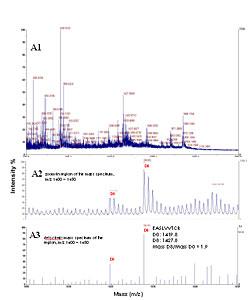
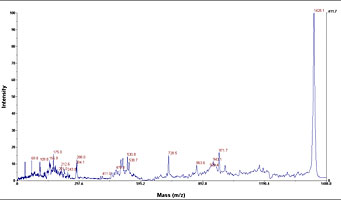
The sequence was identified as EASLVVTCR
Evaluation of novel anticancer drugs
In-vitro drug testing
We have previously shown that over 85% of nasopharyngeal carcinomas (NPC) in Hong Kong demonstrate moderate to strong expression of the epidermal growth factor receptor (EGFR), overexpression of which was associated with poor prognosis. Results from our lab indicate that cetuximab (C225), a humanized chimeric monoclonal anti-EGFR antibody, was capable of enhancing the effects of an anti-cancer drug, paclitaxel, in an additive manner (figure 2). This suggests the possibility of using cetuximab in combination with paclitaxel to improve therapeutic outcomes of NPC patients.
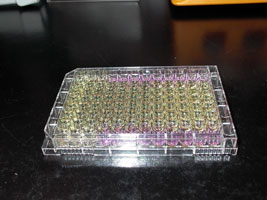
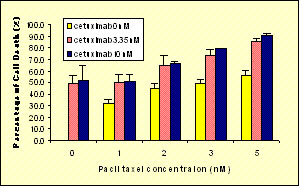
Figure 3. Immunohistochemical staining of the epidermal growth factor receptor (EGFR) in an NPC tissue sample
Models
Apart from in-vitro models for drug testing, our lab also develops in-vivo mouse models to further investigate the effectiveness of novel anticancer drugs. This allows us to evaluate a certain drug in a more similar context as seen in human cancer patients.
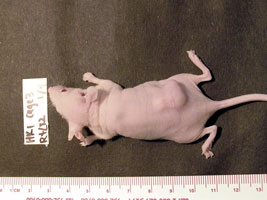
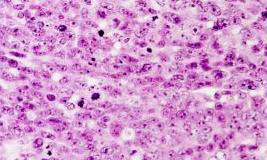
derived from C666-1 cells
Identification and evaluation of the use of alpha feto-protein (AFP) tumour specific variants in HCC diagnosis
Serum -fetoprotein (AFP) is commonly increased in patients with hepatocellular carcinoma, with concentrations ranging from 10 to >500 μg/L. Concentrations greater than 500 μg/L are usually considered diagnostic of hepatocellular carcinoma (HCC). However, moderately increased serum AFP (10–500 μg/L) is also common in nonmalignant chronic liver diseases, leading to low specificity of the AFP test for HCC. This represents a serious drawback as most cases of HCC arise in patients with concurrent chronic liver disease
Figure 1 IEF of Bands I, II and III AFP. LC = Liver Cirrhosis;
HCC = Hepatocellular Carcinoma; GCT = Non-seminomatous germ cell tumours
Using isoelectric focusing (IEF), we have shown that AFP isoform Band +II is relatively specific for HCC. Occasionally, another tumor-specific isoform, Band +III AFP, is also present in HCC cases. We have successfully determined that while Band +I AFP is disialylated AFP, Band +II AFPs are composed of monosialylated AFP. Furthermore, studies conducted in this lab suggest that screening for the Band +II isoform allows early, even preclinical, diagnosis of HCC in high-risk patients.
